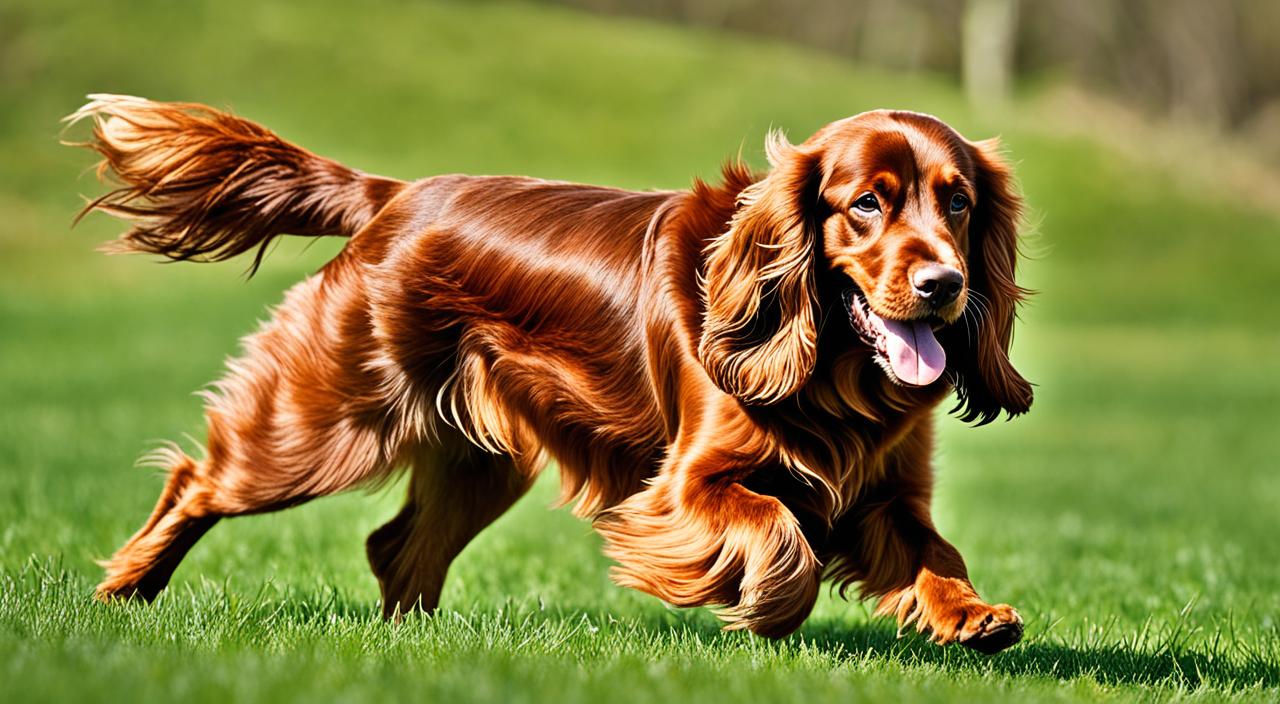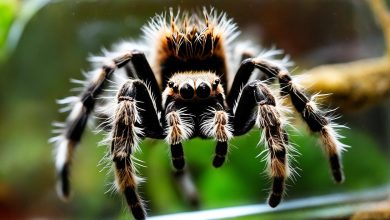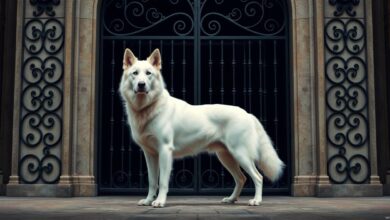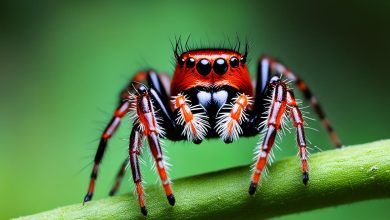Imagine a misty autumn morning in the English countryside. The air smells of damp earth and fallen leaves. Suddenly, a golden-liver blur dashes past, nose to the ground and tail wagging.
This is the Sussex Spaniel, a rare hunting dog. It’s known for its cheerful nature and unwavering dedication. With only 600 in the US, owning one is like having living history.
The Sussex Spaniel, an English breed, dates back to 1792. It was one of the first breeds recognized by the American Kennel Club in 1884. These dogs are prized for their exceptional hunting skills and friendly nature.
Sussex Spaniels stand 13-15 inches tall and weigh up to 45 pounds. They have short legs, long bodies, and a distinctive golden-liver coat. Their sturdy build and deep chest set them apart from other spaniels.
These dogs are known for their gentle temperament and affectionate nature. They have big hazel eyes and heavy brows. Their somber yet cheerful expression reflects their kind-hearted personality.
For over two centuries, Sussex Spaniels have charmed hunters and families alike. Their unique qualities make them beloved companions in any home.
The Rich Heritage of the Sussex Spaniel
Sussex Spaniels have a captivating history as prized gundogs from Sussex. These flushing spaniels emerged in the 18th century. They were crafted for hunting in Sussex County’s dense underbrush.
Origins in Sussex County, England
Sussex Spaniels were born on large estates in Sussex County. They stand 13 to 15 inches high and weigh up to 45 pounds. Their golden liver-colored coat protects them during hunts.
Development as a Field Dog in the 18th Century
As gundogs, Sussex Spaniels excel at following scent trails. They were valued for flushing game and retrieving birds. These dogs once ‘gave tongue’ while working, a trait now bred out.
Near Extinction and Revival Efforts
Sussex Spaniels almost vanished during World War II. Dedicated breeders like Joy Freer saved the breed. Today’s Sussex Spaniels trace back to just six dogs that survived the war.
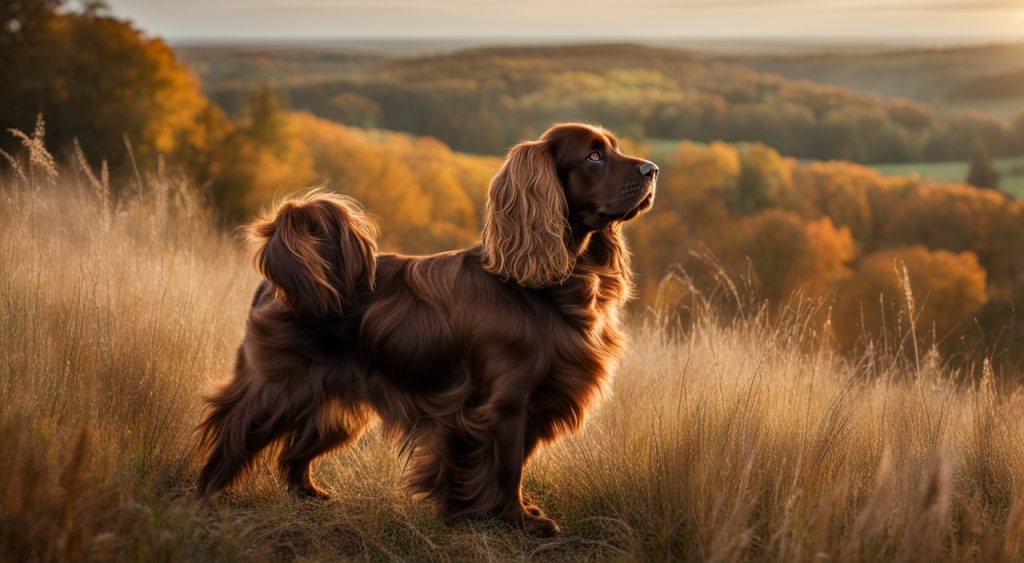
Sussex Spaniels are rare but have achieved notable success. In 2009, a 10-year-old Sussex Spaniel won “Best In Show” at Westminster. Ch. Clussexx Three D Grinchy Glee (Stump) became the oldest dog to win this title.
| Characteristic | Description |
|---|---|
| Average Lifespan | 11-14 years |
| Strengths | Strong, high endurance, affectionate, intelligent |
| Challenges | Prone to weight gain, requires regular grooming |
| Utilization | Rough shooting, beating line, various spaniel tasks |
Physical Characteristics of the Sussex Spaniel
The Sussex Spaniel is a unique medium-sized breed. Its golden-liver coat sets it apart from other spaniels. Standing 13 to 15 inches tall, it weighs between 35 to 45 pounds.
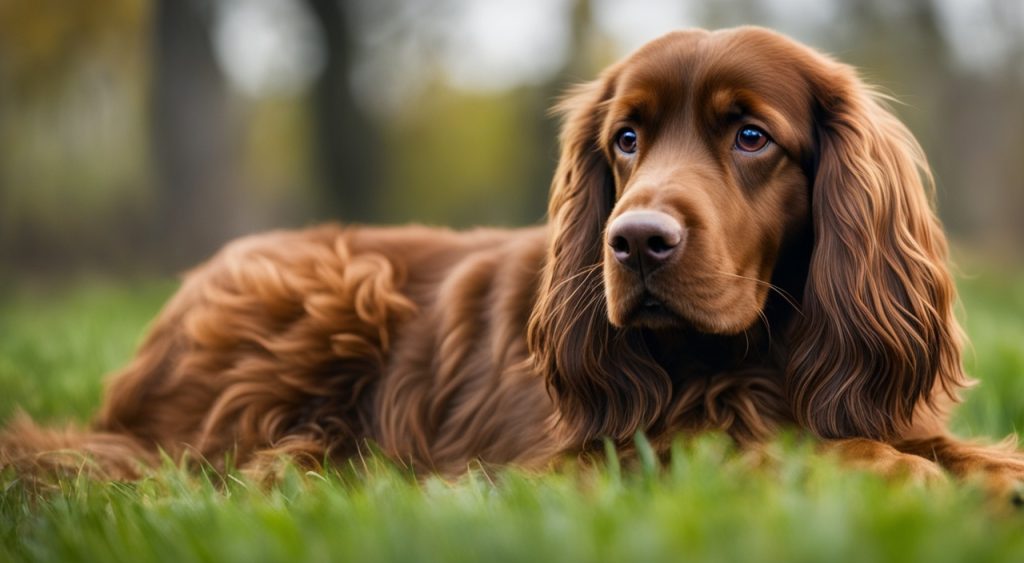
Their coat is dense, slightly wavy, and needs regular grooming. Sussex Spaniels are low-shedding, good for those with mild allergies. Though rare, black, black and tan, or liver with white markings can occur.
Large, expressive hazel eyes reflect their gentle nature. Low-set ears covered in silky hair add to their charm. Short, powerful legs and a broad chest suit their low-to-the-ground hunting style.
| Feature | Description |
|---|---|
| Height | 13-15 inches |
| Weight | 35-45 pounds |
| Coat Color | Golden-liver (predominantly) |
| Coat Type | Dense, slightly wavy |
| Eye Color | Hazel |
| Ear Type | Low-set, covered in silky hair |
The Sussex Spaniel moves with smooth, powerful strides. Their front legs reach well, while strong hindquarters drive them forward. This shows their athletic ability despite their compact size.
Sussex Spaniel: A Unique Hunting Companion
The Sussex Spaniel is a remarkable hunting dog with distinctive traits. This field dog excels in various hunting scenarios. It’s a prized companion for sportsmen.
Exceptional Scenting Abilities
Sussex Spaniels have an incredible nose, setting them apart from other hunting dogs. Their keen sense of smell allows precise game tracking. These flushing spaniels can detect scents that other breeds might miss.
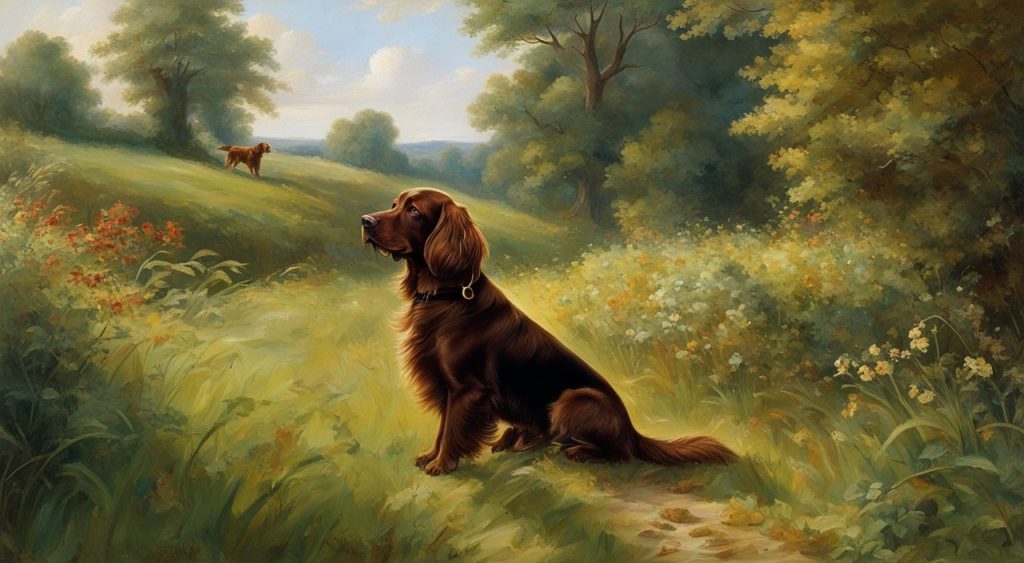
Low-to-the-Ground Hunting Style
The Sussex Spaniel’s unique body structure aids its hunting prowess. Their low-set build helps them navigate dense underbrush. This allows them to move stealthily through challenging terrain.
Vocalization During Hunts
Sussex Spaniels vocalize while hunting, a trait called “giving tongue”. This helps hunters easily track their dog’s location. The dog’s melodious baying adds excitement to the hunting experience.
“The Sussex Spaniel’s voice is music to a hunter’s ears, guiding them through the thrill of the chase.”
Sussex Spaniels are versatile and valuable hunting companions. Their strong flushing instincts and water retrieval skills are assets. These traits make them a top choice for dedicated hunters.
Temperament and Personality Traits
Sussex Spaniels are unique sporting dogs with cheerful dispositions. They make excellent family pets due to their affectionate nature. These versatile companions stand out among other spaniel breeds.
Affectionate and Friendly Nature
Sussex Spaniels are known for their friendly and gentle temperament. They form strong bonds with their families and thrive in loving environments. Their joyful spirit often shows in the characteristic “Sussex grin.”
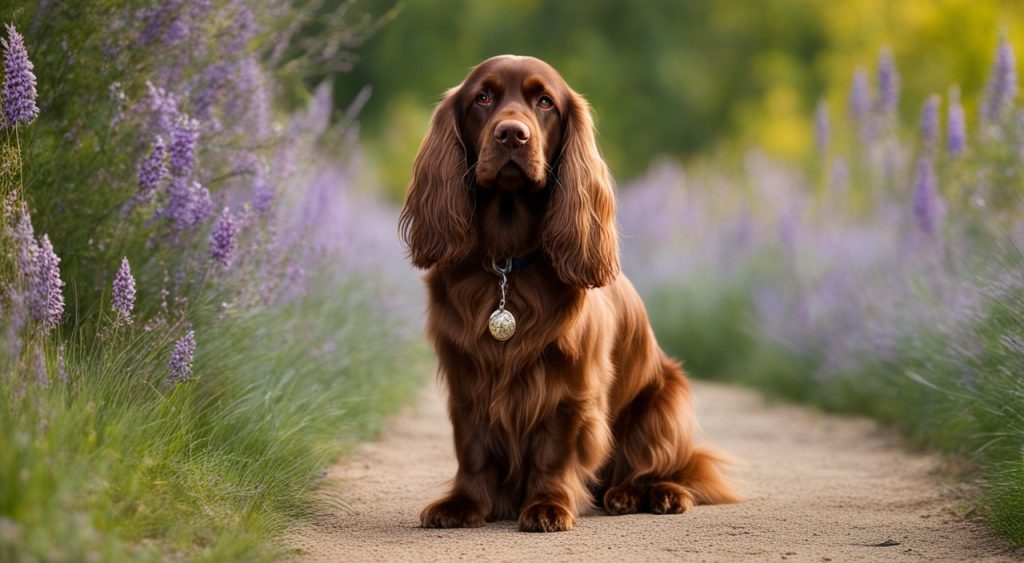
Interaction with Children and Other Pets
With proper socialization, Sussex Spaniels get along well with children and other pets. They need moderate, supervised socialization for harmonious household relationships. Unlike typical spaniels, they can be aloof with strangers.
Sussex Spaniels may show protective behaviors. Early socialization is crucial to ensure they interact well with others.
Intelligence and Trainability
Sussex Spaniels are intelligent dogs that bond closely with their owners. They can be stubborn, so patient and consistent training is necessary. These dogs tend to bark and howl, which is unusual for spaniels.
Training should focus on curbing excessive vocalization. It’s important to channel their energy into positive activities.
| Trait | Description |
|---|---|
| Temperament | Cheerful, gentle, friendly, affectionate, loyal |
| Socialization Needs | Moderate, supervised |
| Training Difficulty | Can be stubborn, requires consistency |
| Vocalization | Prone to barking and howling |
Knowing these traits helps owners care for their Sussex Spaniel. This knowledge ensures a happy and well-adjusted sporting dog.
Grooming and Care Requirements
Sussex Spaniels are low-shedding dogs with special grooming needs. Their dense, wavy coat needs regular care to stay healthy. Brush your Sussex Spaniel every 2-3 days, or more if they get dirty often.
Visit a professional groomer every 6-8 weeks. At home, you’ll need some key tools for grooming. These include dog shampoo, conditioner, towels, brushes, and treats.
- Dog-specific shampoo and conditioner
- Towels for drying
- Grooming brushes
- Treats for positive reinforcement
The Roses Grooming Bundle costs £39.50. It includes a grooming brush, drying brush, and microfibre towels. This kit is great for new Sussex Spaniel owners.
| Grooming Task | Frequency |
|---|---|
| Brushing | Weekly |
| Nail Trimming | Every 2-3 weeks |
| Dental Care | Daily |
| Professional Grooming | Every 6-8 weeks |
Good grooming keeps your Sussex Spaniel looking great and healthy. Regular care prevents matting and reduces shedding. It also lets you check for skin issues or problems.
Exercise Needs and Activity Level
Sussex Spaniels need moderate exercise to stay healthy and happy. These British hunting companions love daily physical activities. They also thrive on mental stimulation to keep them engaged.
Daily Exercise Recommendations
Sussex Spaniels need about 1.5 hours of exercise daily. This can include walks, swimming, and family activities. Monitor their exercise when young to protect developing bones and joints.
Mental Stimulation Importance
Sussex Spaniels are smart dogs with good memory. They learn new commands quickly and enjoy mental challenges. Puzzle toys and training exercises keep their minds sharp and prevent boredom.
Sporting Activities for Sussex Spaniels
As sporting dogs, Sussex Spaniels excel in activities that engage their hunting instincts. They enjoy:
- Retrieving games
- Tracking trials
- Hunt tests
- Water activities (with supervision)
Regular exercise prevents obesity and behavioral issues in Sussex Spaniels. Their moderate activity level suits active owners. They’re not ideal for apartment living without sufficient outdoor time.
| Exercise Type | Duration | Frequency |
|---|---|---|
| Walks | 30-45 minutes | Daily |
| Playtime | 20-30 minutes | 2-3 times daily |
| Swimming | 15-20 minutes | 2-3 times weekly |
| Training exercises | 10-15 minutes | Daily |
Health Considerations for Sussex Spaniels
Sussex Spaniels typically live 11-13 years and face specific health challenges. Regular vet visits are vital for their well-being. These lovable dogs need special attention for certain conditions.
Heart issues are a major concern for Sussex Spaniels. Tetralogy of Fallot can be fatal to puppies before weaning. Adult dogs may develop heart murmurs or enlarged hearts.
Eye problems also affect this breed. Cataracts, retinal dysplasia, and progressive retinal atrophy can impact their vision. Regular eye exams help catch these issues early.
Musculoskeletal problems are common in Sussex Spaniels. Nearly 40% suffer from hip dysplasia, while over 20% have elbow dysplasia. These conditions can cause pain and limit mobility.
| Health Concern | Prevalence | Recommended Care |
|---|---|---|
| Heart Disease | High | Regular cardiac check-ups |
| Hip Dysplasia | ~40% | Weight management, exercise |
| Eye Problems | Common | Annual eye exams |
| Skin/Ear Infections | Prevalent | Regular grooming, ear cleaning |
Good Sussex Spaniel care includes regular vet visits, a balanced diet, and proper exercise. Staying alert to health issues helps these dogs live happier, healthier lives.
The Sussex Spaniel in Modern Times
The Sussex Spaniel has faced challenges in recent times. This charming hunting companion remains rare in the United States. Yet, its unique qualities continue to attract admirers.
Popularity and Rarity
Sussex Spaniels are uncommon in America. In 2008, only 56 puppies were registered. The Kennel Club of Great Britain classified them as a vulnerable native breed in 2004.
AKC Recognition and Show History
The Sussex Spaniel has a long history with the American Kennel Club. It was one of the first nine breeds recognized by the AKC in 1884. The first North American registration was in 1878 for a dog named Jack.
Sussex Spaniels have made their mark in dog shows. In 2009, a 10-year-old Sussex named Stump won Best in Show at Westminster. He beat 144 other breeds and became the oldest dog to win.
Notable Sussex Spaniel Achievements
Sussex Spaniels excel in the field too. Recently, two became the first to earn AKC Master Hunter titles in the US. This shows the breed’s enduring hunting abilities and versatility.
The Sussex Spaniel may be rare, but it has a loyal following. Its recent achievements in shows and hunting trials continue to impress dog enthusiasts.
Training Tips for Sussex Spaniels
Sussex Spaniels need special training methods due to their low AKC breed popularity. These smart dogs can be stubborn but respond well to positive reinforcement. Obedience training works best with encouragement and praise.
Socializing Sussex Spaniels early is key. Start between 3 and 14 weeks old. This helps them become friendly adults who get along with others. Use consistent commands and expectations for the best results.
Training Sussex Spaniels requires patience and consistency. Mix up exercises to keep them interested. Make training fun and engaging to maintain their motivation.
“Teach your Sussex Spaniel to respect you by establishing clear boundaries and using positive reinforcement techniques.”
Housebreaking Sussex Spaniels can be tough. Set a routine and reward good bathroom habits. These dogs need about 1.5 hours of daily exercise.
Regular activity keeps them stimulated and well-behaved. Combine walks, playtime, and mental challenges for a happy, obedient Sussex Spaniel.
| Training Focus | Recommended Approach | Duration |
|---|---|---|
| Socialization | Exposure to various environments and people | 3-14 weeks |
| Obedience | Positive reinforcement, varied exercises | 15-20 minutes daily |
| Housebreaking | Consistent routine, positive reinforcement | First 4-6 months |
| Exercise | Walks, playtime, mental stimulation | 1.5 hours daily |
Choosing a Sussex Spaniel Puppy
Sussex Spaniels are rare, ranking 172nd out of 189 AKC breeds. Finding one may take up to a year. Patience is key when selecting these charming dogs.
Finding Reputable Breeders
Seek breeders who prioritize health and temperament. They should provide orthopedic health certificates for both parents. These include eye, hip, elbow, and heart certifications.
At least one parent should have a DNA test for PDP1. This test should prove they’re Normal/Clear of this metabolic disorder.
Healthy Puppy Characteristics
During puppy selection, observe these traits:
- Clear, bright eyes
- Clean, odor-free ears
- Curious and friendly demeanor
- Healthy weight (adults range 35-45 lbs)
- Proper height (adults measure 13-15 inches)
Preparing Your Home
Puppy-proof your space before bringing your Sussex Spaniel home. These dogs score 2 out of 5 for ease of training. They’re also quite vocal, scoring 4 out of 5.
Sussex Spaniels have a laid-back nature and moderate exercise needs. Gather supplies like a crate, toys, and grooming tools for your new friend.
“A Sussex Spaniel puppy brings joy and companionship, but requires commitment to proper care and training.”
The Sussex Spaniel’s Role in Conservation and Sporting Heritage
The Sussex Spaniel is vital in preserving sporting heritage and aiding conservation efforts. This rare breed arrived in Australia in 1985. It’s now crucial in traditional U.S. hunting practices.
The Sussex Spaniel’s bell-like tongue varies based on the game it encounters. It outperforms many spaniels in speed and endurance. Its vocalizing on scent helps gunners track them easily.
The Sussex Spaniel Club of America promotes the breed’s working abilities. They organize field days and hunt tests to showcase the dog’s skills. These events also contribute to conservation efforts.
The breed’s rarity has led to increased focus on conservation breeding programs. These programs aim to maintain genetic diversity. They also ensure the Sussex Spaniel’s survival for future generations.
The Sussex Spaniel weighs around 50 lbs and has a unique rolling movement. It’s less popular than Brittany or English springers in the U.S. However, it’s valuable in America’s hunting heritage.
This breed plays a key role in wildlife management. It also aids in ethical hunting practices. These traits highlight the importance of preserving the Sussex Spaniel.
FAQ
What is the origin of the Sussex Spaniel?
The Sussex Spaniel emerged in Sussex County, England, during the 18th century. Breeders created this field dog for hunting in thick underbrush. Its unique skills made it popular among hunters.
What are the physical characteristics of the Sussex Spaniel?
Sussex Spaniels have a golden-liver colored coat that’s dense and slightly wavy. Their build is solid with heavy bones and a deep chest. They sport low-set ears and short, powerful legs on a rectangular body.
What makes the Sussex Spaniel a unique hunting companion?
Sussex Spaniels boast exceptional scenting abilities and a low-to-the-ground hunting style. They “give tongue” while following scents, helping hunters track their position. This vocal trait sets them apart from other hunting dogs.
What is the temperament and personality of Sussex Spaniels?
Sussex Spaniels are affectionate and friendly, forming strong bonds with their families. They generally get along well with children and other pets when socialized properly. These dogs are smart but can be stubborn, needing patient and consistent training.
What are the grooming and care requirements for Sussex Spaniels?
Sussex Spaniels need regular grooming to prevent tangles in their dense, wavy coat. Brush them 2-3 times weekly and clean their ears often. Nail trimming and dental care are also important. Despite their thick fur, they don’t shed much.
What are the exercise needs and activity level of Sussex Spaniels?
Sussex Spaniels have moderate activity levels and need regular exercise for good health. Daily walks, playtime, and retrieving games are great for them. Activities that tap into their hunting instincts, like tracking trials, are also beneficial.
What are the common health concerns for Sussex Spaniels?
Heart issues, deafness, eye problems, and hip dysplasia often affect Sussex Spaniels. Regular vet check-ups are crucial for their health. A balanced diet and proper exercise help maintain their well-being.
How popular and rare is the Sussex Spaniel breed?
Sussex Spaniels are rare, with only a few dozen registered in the US yearly. They were among the first nine breeds recognized by the American Kennel Club in 1884.
What are some tips for training Sussex Spaniels?
Training Sussex Spaniels requires patience due to their smart but stubborn nature. Use positive reinforcement and start socializing them early. Mix up exercises and include field training for best results.
What should you consider when choosing a Sussex Spaniel puppy?
Find a reputable breeder who focuses on health and temperament. Look for puppies with clear eyes, clean ears, and friendly personalities. Puppy-proof your home and gather necessary supplies before bringing one home.
What role do Sussex Spaniels play in conservation and sporting heritage?
Sussex Spaniels help preserve sporting heritage through their unique hunting abilities. They contribute to ethical hunting practices and conservation efforts. Organizations work to promote the breed’s skills and maintain genetic diversity.
